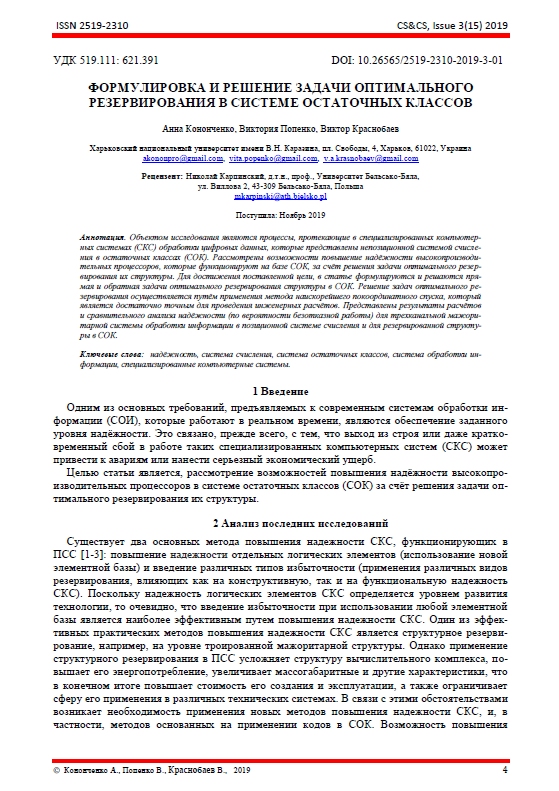The formulation and solution of the task of the optimum reservation in the system of residual classes
Abstract
Processes in specialized computer systems of the handling of the digitized data, which are representing non-positional notation in the system of residual classes (NRC), serve as the object of research. The considered capabilities of increasing the reliability of the high-performance processors, functioning on NRC's base as a result of solving the task of the optimum redundancy of their structure. In order to achieve the goal, direct and inverse tasks of the optimum reservation of the structure in NRC are formulated and solved in the article. The solution of problems of the optimum reservation is carried out by application of a method of the fastest coordinate descent, which is quite exact for carrying out engineering calculations. The results of calculations and comparative analysis of reliability (on the probability of trouble-free operation) for a three-channel majority information processing system are presented, in positional notation and for reservation of the structure in NRC are represented.
Downloads
References
I. Ya. Akushskii and D. I. Yuditskii, Machine Arithmetic in Residual Classes [in Russian]. Moscow: Sov. Radio, 1968.
V. Krasnobayev, A. Yanko and S. Koshman, “A Method for arithmetic comparison of data represented in a residue number system”, Cybernetics and Systems Analysis, vol. 52, Issue 1, pp. 145-150, 2016.
O. Karpenko, A. Kuznetsov, V. Sai and Yu. Stasev, “Discrete Signals with Multi-Level Correlation Function”, Telecommunica-tions and Radio Engineering, vol. 71, Issue 1, pp. 91-98, 2012.
V. Krasnobayev, S. Koshman and M. Mavrina, “A method for increasing the reliability of verification of data represented in a residue number system”, Cybernetics and Systems Analysis, vol. 50, Issue 6, pp. 969-976, 2014.
S. Kavun, A. Zamula and I. Mikheev, “Calculation of expense for local computer networks”, 4th International Scientific-Practical Conference Problems of Infocommunications. Science and Technology (PIC S&T), Kharkov, pp. 146-151, 2017.
V. Krasnobayev and S. Koshman, “A method for operational diagnosis of data represented in a residue number system”, Cyber-netics and Systems Analysis, vol. 54, Issue 2, pp. 336-344, 2018.
O. Kazymyrov, R. Oliynykov and H. Raddum, “Influence of addition modulo 2n on algebraic attacks”, Cryptography and Communications, vol. 8, Issue 2, pp. 277-289, April 2016.
D. A. Patterson , The Morgan Kaufmann Series in Computer Architecture and Design. Morgan Kaufmann, 2016.
A. Yanko, S. Koshman, V. Krasnobayev, “Algorithms of data processing in the residual classes system”, 4th International Scientific-Practical Conference Problems of Infocommunications. Science and Technology (PIC S&T), Kharkiv, pp. 117-121, 2017.
О. Кuznetsov, Yu. Gorbenko, І. Bilozertsev, А. Аndrushkevych and О. Narizhnyi, “Algebraic Immunity of Non-linear Blocks of Symmetric Ciphers”, Telecommunications and Radio Engineering, vol. 77, Issue 4, pp. 309-325, 2018.
A. Kuznetsov, I. Kolovanova and T. Kuznetsova, “Periodic characteristics of output feedback encryption mode”, 4th International Scientific-Practical Conference Problems of Infocommunications. Science and Technology (PIC S&T), Kharkov, pp. 193-198, 2017.
Yu.V. Stasev, A.A. Kuznetsov, A.M. Nosik, “Formation of pseudorandom sequences with improved autocorrelation properties”, Cybernetics and Systems Analysis, vol. 43, Issue 1, pp. 1-11, January 2007.
N. Naumenko, Yu. Stasev, A. Kuznetsov, “Methods of synthesis of signals with prescribed properties”, Cybernetics and Systems Analysis, vol. 43, Issue 3, pp. 321-326, May 2007.
V. Ruzhentsev, R. Oliynykov, “Properties of Linear Transformations for Symmetric Block Ciphers on the basis of MDS-codes”, Proceedings of the 6th International Conference on Network Architecture and Information System Security SAR-SSI, pp. 193-196, 2011.
O. Potii, O. Illiashenko, D. Komin, “Advanced Security Assurance Case Based on ISO/IEC 15408”, Theory and Engineering of Complex Systems and Dependability Advances in Intelligent Systems and Computing, vol. 365, pp. 391-401, 2015.
A. S. Molahosseini, L.Seabra de Sousa, Ch.-H.Chang. Embedded Systems Design with Special Arithmetic and Number Systems, Springer International Publishing, 2017.
V. Dolgov, I. Lisitska, K. Lisitskyi, “The new concept of block symmetric ciphers design”, Telecommunications and Radio Engineering, vol. 76, Issue 2, pp. 157-184, 2017.
A. Kuznetsov, A. Smirnov, D. Danilenko, A. Berezovsky, “The statistical analysis of a network traffic for the intrusion detection and prevention systems”, Telecommunications and Radio Engineering, vol. 74, Issue 1, pp. 61-78, 2015.
R. Gavrylko, Yu. Gorbenko, “A physical quantum random number generator based on splitting a beam of photons”, Telecom-munications and Radio Engineering, vol. 75, Issue 2, pp. 179-188, 2016.


